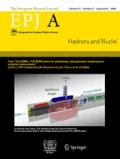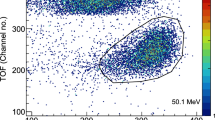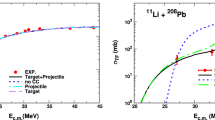Abstract
The present paper examines the effect of temperature-dependent repulsive core potential on the fusion reactions of the \(\alpha \) particle relevant to the production of p-nuclei such as \(^{154}\)Sm, \(^{162}\)Dy, \(^{166}\)Er, and \(^{197}\)Au. For this purpose, the \(\alpha \)-nucleus potentials making use of the double folding model with the density-dependent CDM3Y3 interaction plus the temperature-dependent repulsion (CDM3Y3+Repulsion) are employed. In addition, three nuclear level density (NLD) models of Fermi-Gas (FG), Hartree–Fock BCS (HFBCS), and exact pairing plus independent-particle model (EP+IPM) are used to describe the temperature-dependent excitation energy of the compound nucleus produced in the fusion reaction. The results obtained show that temperature has a significant effect on the repulsive core potential, and different NLD models predict different fusion potentials, especially at high temperatures and near the center point (origin) of the interaction. Going further away from the origin, the repulsive core potential decreases to approximately zero near the barrier region, while at sufficiently far distances, it is least affected by nuclear temperature. The calculated fusion cross sections using the CDM3Y3+Repulsion potential are only affected by the diffuseness parameter of the repulsive potential \(a_\mathrm{{rep.}}\) in the region above the Coulomb barrier, and a good agreement with the experimental data is found at \(a_\mathrm{rep.}=0.35\) fm. Hence, the effect of repulsive potential on the \(\alpha \)-induced reactions is only justified as a correction term, which is added to resolve the Pauli principle problem. This conclusion is in line with those reported previously using similar formalism but for other fusion reactions of heavy nuclei.









Similar content being viewed by others
Data Availability Statement
The manuscript has associated data in a data repository. [Authors’ comment: This is a theoretical work. All the associated data are presented in the published version.]
References
E.M. Burbidge, G.R. Burbidge, W.A. Fowler, F. Hoyle, Synthesis of the elements in stars. Rev. Mod. Phys. 29, 547 (1957)
A.G.W. Cameron, Stellar evolution, nuclear astrophysics, and nucleogenesis. Technical Report (Atomic Energy of Canada Ltd., Chalk River, 1957)
D.D. Clayton, W.A. Fowler, T.E. Hull, B.A. Zimmerman, Neutron capture chains in heavy element synthesis. Ann. Phys. 12, 331 (1961)
D.D. Clayton, R.A. Ward, s-Process studies: exact evaluation of an exponential distribution of exposures. Astrophys. J. 193, 397 (1974)
F. Käppeler, R. Gallino, S. Bisterzo, W. Aoki, The s-process: nuclear physics, stellar models, observations. Rev. Mod. Phys. 83, 157 (2011)
S. Bisterzo, C. Travaglio, M. Wiescher, F. Kappeler, R. Gallino, Galactic chemical evolution: the impact of the \(^{13}\)C-pocket structure on the s-process distribution. Astrophys. J. 835, 97 (2017)
D. Argast, M. Samland, F.-K. Thielemann, Y.-Z. Qian, Neutron star mergers versus core-collapse supernovae as dominant r-process sites in the early Galaxy. Astron. Astrophys. 416, 997 (2004)
F. Matteucci, D. Romano, A. Arcones, O. Korobkin, S. Rosswog, Europium production: neutron star mergers versus core-collapse supernovae. Mon. Not. R. Astron. Soc. 438, 2177 (2014)
B. Wehmeyer, M. Pignatari, F.-K. Thielemann, Galactic evolution of rapid neutron capture process abundances: the inhomogeneous approach. Mon. Not. R. Astron. Soc. 452, 1970 (2015)
J.M. Lattimer, D.N. Schramm, Black-hole-neutron-star collisions. Astrophys. J. 192, L145 (1974)
C. Freiburghaus, S. Rosswog, F.-K. Thielemann, r-Process in neutron star mergers. Astrophys. J. 525, L121 (1999)
D. Radice, F. Galeazzi, J. Lippuner, L.F. Roberts, C.D. Ott, L. Rezzolla, Dynamical mass ejection from binary neutron star mergers. Mon. Not. R. Astron. Soc. 460, 3255 (2016)
F.-K. Thielemann, M. Eichler, I.V. Panov, B. Wehmeyer, Neutron star mergers and nucleosynthesis of heavy elements. Annu. Rev. Nucl. Part. Sci. 67, 253 (2017)
D.L. Lambert, The p-nuclei: abundances and origins. Astron. Astrophys. Rev. 3, 201 (1992)
M. Arnould, S. Goriely, The p-process of stellar nucleosynthesis: astrophysics and nuclear physics status. Phys. Rep. 384, 1 (2003)
T. Rauscher, N. Dauphas, I. Dillmann, C. Fröhlich, Z. Fülöp, G. Gyürky, Constraining the astrophysical origin of the p-nuclei through nuclear physics and meteoritic data. Rep. Prog. Phys. 76, 066201 (2013)
T. Rauscher, Branchings in the \(\gamma \) process path revisited. Phys. Rev. C 73, 015804 (2006)
W. Rapp, J. Görres, M. Wiescher, H. Schatz, F. Käppeler, Sensitivity of p-Process nucleosynthesis to nuclear reaction rates in a 25 M\(_\odot \) supernova model. Astrophys. J. 653, 474 (2006)
T. Szücs, I. Dillmann, R. Plag, Z. Fülöp, KADoNiS-p: the astrophysical p-process database. Nucl. Data Sheets 120, 191 (2014)
T. Rauscher, F.-K. Thielemann, Astrophysical reaction rates from statistical model calculations. At. Data Nucl. Data Tables 75, 1 (2000)
P. Mohr, Z. Fülöp, H. Utsunomiya, Photo-induced nucleosynthesis: current problems and experimental approaches. Eur. Phys. J. A 32, 357 (2007)
G.G. Kiss, T. Szücs, T. Rauscher, Z. Török, L. Csedreki, Z. Fülöp, G. Gyürky, Z. Halász, Measurement of (\(\alpha ,n\)) reaction cross sections of erbium isotopes for testing astrophysical rate predictions. J. Phys. G 42, 055103 (2015)
C. Yalçin, R. T. Güray, N. Özkan, S. Kutlu, G. Gyürky, J. Farkas, G.G. Kiss, Z. Fülöp, A. Simon, E. Somorjai, T. Rauscher, Odd \(p\) isotope \(^{113}\)In: measurement of \(\alpha \)-induced reactions. Phys. Rev. C 79, 065801 (2009)
G.G. Kiss, P. Mohr, Z. Fülöp, D. Galaviz, G. Gyürky, Z. Elekes, E. Somorjai, A. Kretschmer, K. Sonnabend, A. Zilges, M. Avrigeanu, High precision \(^{89}\)Y(\(\alpha ,\alpha \))\(^{89}\)Y scattering at low energies. Phys. Rev. C 80, 045807 (2009)
G. Gyürky, Z. Elekes, J. Farkas, Z. Fülöp, Z. Halász, G.G. Kiss, E. Somorjai, T. Szücs, R.T. Güray, N. Özkan, Alpha-induced reaction cross section measurements on \(^{151}\)Eu for the astrophysical \(\gamma \)-process. J. Phys. G 37, 115201 (2010)
T. Rauscher, G.G. Kiss, T. Szucs, Z. Fulop, C. Frohlich, G. Gyurky, Z. Halasz, Z. Kertesz, E. Somorjai, Astrophysical analysis of the measurement of \((\alpha ,\gamma )\) and (\(\alpha ,n)\) cross sections of \(^{169}\)Tm. Phys. Rev. C 86, 015804 (2012)
Z. Korkulu, G.G. Kiss, T. Szucs, Z. Fulop, G. Gyurky, E. Somorjai, Z. Halasz, N. Ozkan, R.T. Guray, C. Yalcin, Cross section measurements of the \(^{121}\)Sb(\(\alpha ,\gamma \))\(^{125}\)I reaction at astrophysical energies. ATOMKI Ann. Rep. 34 (2011)
L. Netterdon, P. Demetriou, J. Endres, U. Giesen, G.G. Kiss, A. Sauerwein, T. Szucs, K.O. Zell, A. Zilges, Investigation of \(\alpha \)-induced reactions on the p nucleus. Nucl. Phys. A 916, 149 (2013)
A. Palumbo et al., Systematic study of the \(\alpha \)-optical potential via elastic scattering near the \(Z = 50\) region for p-process nuclei. Phys. Rev. C 85, 035808 (2012) [Erratum: Phys. Rev. C 88, 039902 (2013)]
G.G. Kiss, T. Szucs, T. Rauscher, Z. Torok, Z. Fulop, G. Gyurky, Z. Halasz, E. Somorjai, Alpha induced reaction cross section measurements on \(^{162}\)Er for the astrophysical \(\gamma \) process. Phys. Lett. B 735, 40 (2014)
A. Ornelas et al., The \(^{106}\)Cd\((\alpha, \alpha )^{106}\)Cd elastic scattering in a wide energy range for \(\gamma \) process studies. Nucl. Phys. A 940, 194 (2015)
Z. Halasz et al., Experimental study of the astrophysical \(\gamma \)-process reaction \(^{124}\)Xe\((\alpha ,\gamma )^{128}\)Ba. Phys. Rev. C 94, 045801 (2016)
V. Avrigeanu, M. Avrigeanu, Analysis of uncertainties in \(\alpha \)-particle optical-potential assessment below the Coulomb barrier. Phys. Rev. C 94, 024621 (2016)
G.G. Kiss, T. Szucs, P. Mohr, Z. Torok, R. Huszank, G. Gyurky, Z. Fulop, \(\alpha \)-induced reactions on \(^{115}\)In: cross section measurements and statistical model analysis. Phys. Rev. C 97, 055803 (2018)
T. Szucs, P. Mohr, G. Gyurky, Z. Halasz, R. Huszank, G.G. Kiss, T.N. Szegedi, Z. Torok, Z. Fulop, Cross section of \(\alpha \)-induced reactions on \(^{197}\)Au at sub-Coulomb energies. Phys. Rev. C 100, 065803 (2019)
W. Hauser, H. Feshbach, The inelastic scattering of neutrons. Phys. Rev. 87, 366 (1952)
S.E. Woosley, W.M. Howard, The p-process in supernovae. Astrophys. J. Suppl. Ser. 36, 285 (1978)
J.L. Fisker, R.D. Hoffman, J. Pruet, On the origin of the lightest Molybdenum isotopes. Astrophys. J. 690, L135 (2009)
T. Rauscher, N. Dauphas, I. Dillmann, C. Fröhlich, Z. Fülöp, G. Gyürky, Constraining the astrophysical origin of the p-nuclei through nuclear physics and meteoritic data. Rep. Prog. Phys. 76, 066201 (2013)
N. Özkan, G. Efe, R.T. Güray, A. Palumbo, J. Gorres, H.Y. Lee, L.O. Lamm, W. Rapp, E. Stech, M. Wiescher, G. Gyürky, Z. Fülöp, E. Somorjai, Astrophysical S factor for \(\alpha \)-capture on \(^{112}\)Sn in the p-process energy range, Astrophysical \(S\) factor for \(\alpha \)-capture on \(^{112}\)Sn in the \(p\)-process energy range. Phys. Rev. C 75, 025801 (2007)
P. Scholz, A. Endres, A. Hennig, L. Netterdon, H.W. Becker, J. Endres, J. Mayer, U. Giesen, D. Rogalla, F. Schluter, S.G. Pickstone, K.O. Zell, A. Zilges, Measurement of the \(^{187}\)Re(\(\alpha , n\))\(^{190}\)Ir reaction cross section at sub-Coulomb energies using the Cologne Clover Counting Setup. Phys. Rev. C 90, 065807 (2014)
L. Netterdon, J. Mayer, P. Scholz, A. Zilges, Total and partial cross sections of the \(^{112}\)Sn\((\alpha , n)^{116}\)Te reaction measured via in-beam \(\gamma \)-ray spectroscopy. Phys. Rev. C 91, 035801 (2015)
G. Michaud, Experimental evidence for repulsive cores in heavy-ion reactions. Phys. Rev. C 8(2), 525 (1973)
A.S. Umar, V.E. Oberacker, Heavy-ion interaction potential deduced from density-constrained time-dependent Hartree–Fock calculation. Phys. Rev. C 74, 021601(R) (2006)
T. Nakatsukasa, K. Matsuyanagi, M. Matsuo, K. Yabana, Time-dependent density-functional description of nuclear dynamics. Rev. Mod. Phys. 88, 045004 (2016)
A.S. Umar, V.E. Oberacker, \(^{64}\)Ni+\(^{132}\)Sn fusion within the density-constrained time-dependent Hartree–Fock formalism. Phys. Rev. C 76, 014614 (2007)
A.S. Umar, V.E. Oberacker, J.A. Maruhn, P.-G. Reinhard, Entrance channel dynamics of hot and cold fusion reactions leading to superheavy elements. Phys. Rev. C 81, 064607 (2010)
A.S. Umar, V.E. Oberacker, C.J. Horowitz, Microscopic sub-barrier fusion calculations for the neutron star crust. Phys. Rev. C 85, 055801 (2012)
C.F. von Weizsäcker, Zur Theorie der Kernmassen. Z. Phys. A 96, 431 (1935)
K. Washiyama, D. Lacroix, Energy dependence of the nucleus-nucleus potential close to the Coulomb barrier. Phys. Rev. C 78, 024610 (2008)
Y. Hashimoto, G. Scamps, Gauge angle dependence in time-dependent Hartree–Fock–Bogoliubov calculations of \(^{20}\)O + \(^{20}\)O head-on collisions with the Gogny interaction. Phys. Rev. C 94, 014610 (2016)
G. Scamps, Y. Hashimoto, Transfer probabilities for the reactions \(^{14,20}\)O+\(^{20}\)O in terms of multiple time-dependent Hartree–Fock–Bogoliubov trajectories. Phys. Rev. C 96, 031602 (2017)
C. Simenel, A.S. Umar, Heavy-ion collisions and fission dynamics with the time-dependent Hartree–Fock theory and its extensions. Prog. Part. Nucl. Phys. 103, 19 (2018)
J. Blocki, J. Randrup, W.J. Swiatecki, C.F. Tsang, Proximity forces. Ann. Phys. 105, 427 (1977)
W. Reisdorf, Analysis of fissionability data at high excitation energies. Z. Phys. A 300, 227 (1981)
J.R. Birkelund, J.R. Huizenga, Fusion reactions between heavy nuclei. Annu. Rev. Nucl. Part. Sci. 33, 265 (1983)
W.D. Myers, W.J. Świa̧tecki, Nucleus-nucleus proximity potential and superheavy nuclei. Phys. Rev. C 62, 044610 (2000)
G.R. Satchler, W.G. Love, Folding model potentials from realistic interactions for heavy-ion scattering. Phys. Rep. 55, 183 (1979)
S. Misicu, H. Esbensen, Hindrance of heavy-ion fusion due to nuclear incompressibility. Phys. Rev. Lett. 96, 112701 (2006)
S. Misicu, H. Esbensen, Signature of shallow potentials in deep sub-barrier fusion reactions. Phys. Rev. C 75, 034606 (2007)
S. Misicu, F. Carstoiu, Absence of a maximum in the S factor at deep sub-barrier energies in the fusion reaction \(^{40}\)Ca + \(^{40}\)Ca. Phys. Rev. C 84, 051601(R) (2011)
G. Montagnoli et al., Fusion of \(^{40}\)Ca + \(^{40}\)Ca and other Ca+Ca systems near and below the barrier. Phys. Rev. C 85, 024607 (2012)
O.N. Ghodsi, R. Gharaei, Temperature dependence of the repulsive core potential in heavy-ion fusion reactions. Phys. Rev. C 85, 064620 (2012)
F. Ghorbani, S.A. Alavi, V. Dehghani, A. Soylu, F. Koyuncu, Heavy ion fusion reaction cross section: Analysis of the temperature dependence of the repulsive nuclear potential. Phys. Rev. C 102, 014610 (2020)
A.J. Cole, Statistical models for nuclear decay: from evaporation to vaporization (Institute of Physics Publishing, Bristol, 2000)
R. Capote et al., A reference input parameter library for calculation of nuclear reactions and nuclear data evaluations. Nucl. Data Sheets 110, 3107 (2009)
D. Bucurescu, T. von Egidy, Correlations between the nuclear level density parameters. Phys. Rev. C 72, 067304 (2005)
S. Goriely, F. Tondeur, J.M. Pearson, A Hartree–Fock nuclear mass table. At. Data Nucl. Data Tables 77, 311 (2001)
P. Demetriou, S. Goriely, Microscopic nuclear level densities for practical applications. Nucl. Phys. A 695, 95 (2001)
N. Quang Hung, N. Dinh Dang, L.T. Quynh Huong, Simultaneous microscopic description of nuclear level density and radiative strength function. Phys. Rev. Lett. 118, 022502 (2017)
N.D Dang, N. Quang Hung, L.T. Quynh Huong, Testing the constant-temperature approach for the nuclear level density. Phys. Rev. C 96, 054321 (2017)
N. Quang Hung, N. Dinh Dang, L.G. Moretto, Pairing in excited nuclei: a review. Rep. Prog. Phys. 82, 056301 (2019)
B. Dey, D. Pandit, S. Bhattacharya, N. Quang Hung, N. Dinh Dang, L. Tan Phuc, D. Mondal, S. Mukhopadhyay, S. Pal, A. De, S.R. Banerjee, Level density and thermodynamics in the hot rotating \(^{96}\)Tc nucleus. Phys. Rev. C 96, 054326 (2017)
B. Dey, N. Quang Hung, D. Pandit, S. Bhattacharya, N. Dinh Dang, L.T. Quynh Huong, D. Mondal, S. Mukhopadhyay, S. Pal, A. De, S.R. Banerjee, S-shaped heat capacity in an odd-odd deformed nucleus. Phys. Lett. B 789, 634 (2019)
L. Tan Phuc, N. Quang Hung, N. Dinh Dang, L.T. Quynh Huong, N. Ngoc Anh, N. Ngoc Duy, L. Ngoc Uyen, N. Nhu Le, Role of exact treatment of thermal pairing in radiative strength functions of 161-163Dy nuclei, Phys. Rev. C 102, 061302(R) (2020)
C.Y. Wong, Interaction barrier in charged-particle nuclear reactions. Phys. Rev. Lett 31, 766 (1973)
D.L. Hill, J.A. Wheeler, Nuclear constitution and the interpretation of fission phenomena. Phys. Rev. 89, 1102 (1953)
I.I. Gontchar, M.V. Chushnyakova, A C-code for the double folding interaction potential of two spherical nuclei. Comput. Phys. Comm. 181, 168 (2010)
Ş Mişicu, H. Esbensen, Hindrance of heavy-ion fusion due to nuclear incompressibility. Phys. Rev. Lett. 96, 112701 (2006)
Ş Mişicu, H. Esbensen, Signature of shallow potentials in deep sub-barrier fusion reactions. Phys. Rev. C 75, 034606 (2007)
W.D. Myers, W.J. Śewia̧tecki, Nuclear equation of state. Phys. Rev. C 57, 3020 (1998)
M. Abd-Alla, The temperature dependence of the level density parameter. Acta Phys. Pol. B 23, 807 (1992)
S. Gil, R. Vandenbosch, A.J. Lazzarini, D.-K. Lock, A. Ray, Spin distribution of the compound nucleus in heavy ion reactions at near-barrier energies. Phys. Rev. C 31, 1752 (1985)
R. Broda, M. Ishihara, B. Herskind, H. Oeschler, S. Ogaza, H. Ryde, Heavy-ion fusion cross sections. Nucl. Phys. A 248, 356 (1975)
S. Gil, R. Vandenbosch, A. Charlop, A. Garca, D.D. Leach, S.J. Luke, S. Kailas, Spin distribution of the compound nucleus formed by \(^{16}\)O+\(^{154}\)Sm. Phys. Rev. C 43, 701 (1991)
D.L. Uhl, T.L. McDaniel, J.W. Cobble, Search for evidence of ternary fission induced in \(^{197}\)Au, \(^{209}\)Bi, and \(^{239}\)Pu by intermediate-energy helium ions. Phys. Rev. C 4, 1357 (1971)
J. Ralarosy, M. Debeauvais, G. Remy, J. Tripier, R. Stein, D. Huss, Fission cross sections of uranium, thorium, bismuth, lead, and gold induced by 58- to 100-MeV alpha particles. Phys. Rev. C 8, 2372 (1973)
Acknowledgements
This research is supported by the National Foundation for Science and Technology Development of Vietnam (NAFOSTED) under Grant Number 10/2020/STS02.
Author information
Authors and Affiliations
Corresponding authors
Additional information
Communicated by Alexis Diaz-Torres.
Rights and permissions
About this article
Cite this article
Le, N.N., Duy, N.N. & Hung, N.Q. Examination of \(\alpha \)-induced fusion reactions relevant to the production of p-nuclei. Eur. Phys. J. A 57, 187 (2021). https://doi.org/10.1140/epja/s10050-021-00498-5
Received:
Accepted:
Published:
DOI: https://doi.org/10.1140/epja/s10050-021-00498-5




